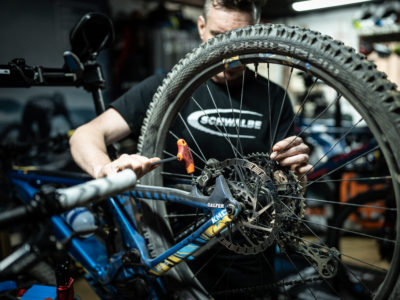A high-pitched sound when braking. A persistent squeal on a downhill. Or a metallic hum that seems to come out of nowhere. Bicycle brake noises are one of the most common—and frustrating—annoyances for any cyclist, whether on the road or off-road.
Although they don’t always indicate a serious issue, these sounds can affect safety, braking efficiency, and of course, the enjoyment of every ride. In many cases, they are a sign that something is misaligned, dirty, or worn out and needs attention.
In this article, we’ll help you identify the type of noise you’re hearing, its possible causes, and most importantly, how to eliminate it effectively. We’ll also give you practical tips to prevent noises from returning and to keep your brakes in top condition.
Why Do Bicycle Brakes Make Noise?
Brake noises can have different origins, but in all cases they signal that something is interfering with the optimal function of the braking system. Identifying the type of noise and its cause is the first step in eliminating it.
Most Common Types of Noise
- Constant metallic squeal: usually happens during braking and may be caused by contamination of the disc or pads, poor bedding-in, or excessive wear.
- High-pitched squeal: common with sintered pads or wet discs. It may disappear as the system heats up, or worsen if residue is present.
- Intermittent vibrations: felt as a hum or rumble through the bike. Often linked to misaligned calipers, warped discs, or loose bolts.
General Causes of Brake Noise
- Contaminated discs or pads: oil, grease, or improper products that reduce friction and generate noise.
- Uneven or excessive wear: on both pads and discs, altering the contact surface and causing vibrations.
- Misaligned brakes: an off-center caliper can cause irregular rubbing on the disc.
- Incorrect installation: loose bolts, poorly fitted pads, or improper bedding-in.
- Weather conditions: humidity, rain, or mud can cause temporary squealing or worsen existing issues.
Understanding what type of noise you hear and what causes it is key to applying the right solution. In the next section, we’ll show you how to identify the exact origin step by step.
How to Identify the Source of the Noise
Locating the exact cause of brake noise is essential to apply the right fix. Although in many cases it’s just a simple cleaning or alignment issue, a systematic check of the braking system is recommended.
Step-by-Step Diagnosis
- Visual inspection of the disc
Check for dirt, oil stains, grease, or signs of excessive wear. Look for warping or discoloration from overheating. - Pad check
Inspect if pads are worn, glazed, or contaminated. Pads should be of uniform thickness and matte, not shiny. If shiny or burnt-smelling, they are likely crystallized. - Alignment check
Spin the wheel to see if the disc rubs against the pads or wobbles side to side. - Fastener check
Ensure all bolts are tightened, especially those holding the caliper, lever, and disc. - Bedding-in or recent installation
If pads or discs are new, remember they need a break-in period. Some light noise is normal during this stage.
This basic check will help you isolate the issue and act precisely. In the next section, we’ll see what practical solutions you can apply depending on the diagnosis.
Practical Solutions to Eliminate Brake Noise
Once you’ve identified the cause, it’s time to apply effective fixes. In many cases, small adjustments or quick cleanings are enough to restore quiet, effective braking.
1. Deep Cleaning of Discs and Pads
- Discs: use a specific brake cleaner (never lubricants or household degreasers) and a clean, residue-free cloth. For stubborn stains, gently rub with fine sandpaper (400–600 grit).
- Pads: if contaminated (visible stains), sand lightly and clean with air or a dry cloth. If stains persist, replace them, as pads are porous and cannot be fully recovered.
Pro tip: avoid touching discs or pads with bare hands to prevent contamination from natural skin oils.
2. Caliper Alignment
- Slightly loosen caliper bolts.
- Press the brake lever to center it automatically over the disc.
- While holding the lever, re-tighten the bolts.
- Spin the wheel to check for rubbing.
This quick adjustment can eliminate vibrations or humming caused by poor alignment.
3. Replace Worn or Damaged Components
If noises persist after cleaning and alignment, components may be worn:
- Replace warped or deeply scratched discs.
- Replace glazed, contaminated, or overly thin pads.
- Check bolts and adapters for looseness or wear.
4. Proper Bedding-In After Installation
After installing new pads, perform a bedding-in process to ensure uniform contact. Do 25–30 progressive stops from medium speed (10–20 km/h) to a near stop, without wheel lock, and let the system cool between stops.
This often-overlooked step helps prevent noise from the start and improves overall braking performance.
How to Prevent Brake Noise from Returning
Once the issue is fixed, it’s important to adopt preventive habits that will keep your braking system quiet and efficient long-term. These practices not only reduce the chance of noise but also extend component lifespan.
1. Regular Cleaning
Keep discs and pads clean, especially after rides in dust, mud, rain, or if transporting your bike by car (where road residues can accumulate). A quick wipe with brake cleaner after demanding rides helps prevent contamination.
2. Proper Storage
Avoid leaving your bike exposed to dust, moisture, or environments with chemicals (like lubricants or cleaning sprays) that can settle on the braking system and contaminate it. Store it in a clean, ventilated space.
3. Frequent Visual Checks
Every few rides, quickly check disc and pad condition: look for unusual shine, residues, excessive wear, or loose bolts. Spotting issues early is the best way to prevent noise or major failures.
4. Correct Bedding-In of New Pads
After replacing pads or discs, always perform the bedding-in process (as explained earlier). Skipping this is one of the most common causes of premature noise.
5. Don’t Mix Old and New Components
Avoid pairing new pads with heavily worn discs, and never install new discs with worn pads. The contact surface won’t seat properly, which may cause noise and reduce performance.
Bicycle brake noises may seem like a minor annoyance, but in reality, they’re a clear warning that something isn’t working as it should. Ignoring them not only affects comfort but also compromises safety and accelerates wear of key components.
As you’ve seen, identifying the cause of noise and applying the right fixes is straightforward and within reach of any cyclist, regardless of technical level. With regular cleaning, basic inspections, and correct installation, you can enjoy a quiet, safe, and durable braking system.
Have specific questions or want to keep learning about bike maintenance? Explore our other related articles and discover more useful tips to improve your cycling performance every ride.

